The best shrimp fajitas have shrimp that are seared and then cooked gently, the seasoning is perfect, and the pan sizzles when they’re done!
I used to think that fajitas at restaurants were always better than fajitas made at home. That was probably because my home fajitas didn’t sizzle, and my veggies weren’t quite as good as theirs. But, I have changed all of that. I’ve figured out how to make the pan sizzle, and how to make the veggies taste just like the ones at my favorite Mexican restaurant. Now you get to find out how too!
Scroll down to read more about how it all comes together or click here to jump straight down to the recipe.
- How To Make The Best Shrimp Fajitas
- What Kind Of Pan To Use For Shrimp Fajitas
- How to Cook the Shrimp
- How to Make Fajita Vegetables
- What’s in Fajita Seasoning
- How To Make the Pan of Fajitas Sizzle
- Fajita Toppings
- Sheet Pan Shrimp Fajitas
- More Fantastic Fajita Recipes
- Podcast Episode About Shrimp Fajitas
- Shrimp Fajitas Recipe
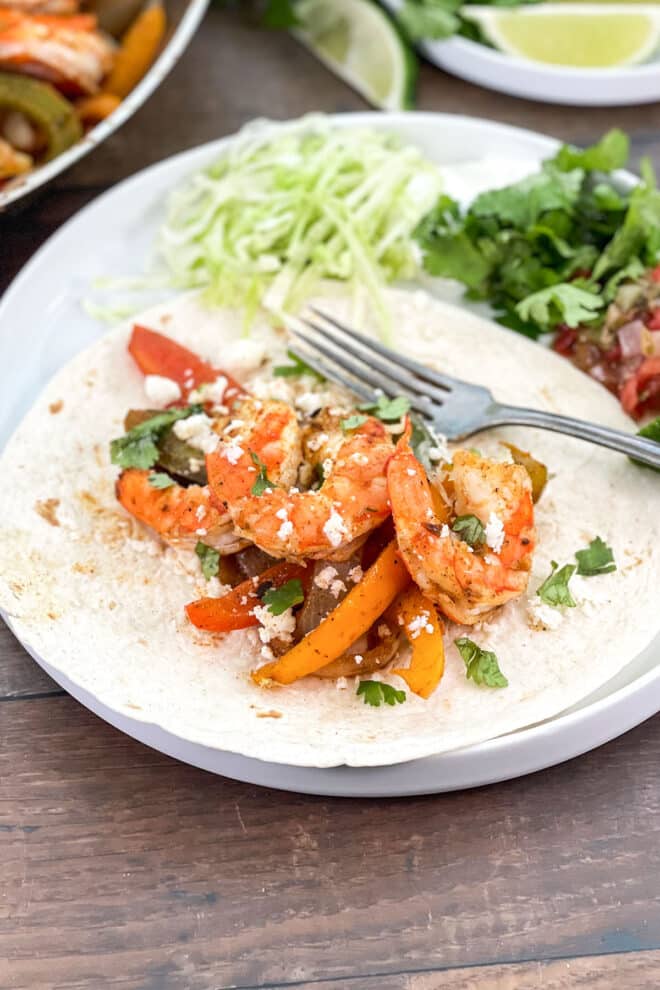
How To Make The Best Shrimp Fajitas
There are four important parts to making the best shrimp fajitas:
- The shrimp need to be seared but also cooked gently so that they don’t get dry.
- The veggies also need a searing, but then we want them tender.
- The seasonings have to be that familiar blend of smoky, floral, and citrus flavors.
- And the whole pan needs to be sizzling when it comes to the table!
To achieve the perfect shrimp, we’ll be cooking them in two stages. High heat first to sear them, and then they rest before going into the pan with the seasonings and veggies to cook through more gently.
The bell peppers and onions are cut into strips. Then, like the shrimp, they’re seared until lightly charred. The final touch to perfect fajita vegetables is a bit of liquid added after searing to help them get tender without overcooking them.
The seasoning blend, well, that’s a whole thing. I’ve got a copycat fajita seasoning mix for you that tastes just like the store-bought packets, and just like what you find in restaurants too.
Finally, how do you get that sizzle? I will reveal all below! There are also some great tips coming up for what kind of pan to use, how to keep tortillas warm at the table, how to know when your shrimp are cooked, and more!
What Kind Of Pan To Use For Shrimp Fajitas
When it comes to making fajitas, you really need some consistent high heat. I find this easiest to achieve with a heavy-bottomed skillet because it holds the heat evenly. My go-to is a cast iron. But a stainless steel skillet with a heavy core in its bottom will work too. If you use a metal pan that isn’t cast iron, don’t be surprised if the bottom of the pan gets dark. That’s normal because we’re cooking the veggies for awhile.
If you have a nonstick skillet instead, it will be easier to clean, for sure. Just know that you will likely have a bit of trouble getting that good sear going on the shrimp and the veggies. It will still taste good though!
How to Cook the Shrimp
What we’re going to do here might be counterintuitive, but stay with me. You see, shrimp cook really quickly, more quickly than it takes for bell pepper strips to get tender. For that reason, a lot of recipes will start by cooking the peppers and onions, and then adding the shrimp at the end. The problem with that is that it’s nearly impossible to get a nice sear on shrimp when they’re crowded in a panful of steamy vegetables.
For really delicious shrimp that also look great, you want to get a nice sear on them. To do that, you’ll actually start by searing the shrimp in a hot pan first. But you’re just getting that sear on them. Then you remove them to a clean plate and let them rest. They will continue to cook gently a bit as they rest just from their own residual heat.
Once the veggies are cooked, you’ll be adding the shrimp to them to finish cooking and to heat back through. All of this gets you those more gently-cooked, plump and juice shrimp, with the flavor and texture of a good sear.
What Kind of Shrimp to Use for Fajitas
Shrimp fajitas are really all about the shrimp, so this is one of those recipes where I figure, go big or go home! I therefore prefer to use jumbo shrimp. Also, the jumbo shrimp can take the heat for longer, so they can really get that sear we were talking about.
However, jumbo shrimp are among the most expensive shrimp, so I only buy them when they’re on sale. When they’re not on sale, I get extra large or large. Anything smaller and the shrimp will get overcooked and dry from the high heat.
For fajitas, I get shrimp that are already peeled and deveined and with the tails off. You don’t want the tails in those tortillas! If you get them with tails on, that’s okay. Just remove them before cooking by pinching the tail between your fingers with one hand while the other hand tugs the shrimp from the base just where the tail and shrimp meet up.
I prefer to buy frozen shrimp. These are usually frozen right when they’re caught, meaning that they’re as close to the sea as possible, and the freshest possible. If you buy already defrosted shrimp, then you don’t know how long they’ve been sitting thawed for. If you’re getting frozen shrimp, as recommended, here’s a quick way to defrost them right before cooking.
I’ve been asked if I marinade the shrimp before cooking them. My answer is no. There’s going to be a lot of flavors going on, and we’re cooking the shrimp in the perfect way, so a marinade isn’t needed.
How to Know When the Shrimp Are Done
Shrimp are fascinating because they have a built in readiness thermometer. They actually change color and texture when they’re finished cooking. Shrimp usually start out kind of grey and a bit translucent, like a jelly-ish texture. When they are fully cooked, they will be pink and white, no longer translucent, and with a firmer texture. They also curl up a bit more once they’re cooked.
As soon as the shrimp no longer have that translucence, they’re pink, and they’re curled, with no slick or jelly texture, they are done.
How to Make Fajita Vegetables
The trick to amazing fajita vegetables is similar to what we learned about cooking fajita shrimp. You want them to have a good sear for some light charred flavor. But, if you cook them at that searing temperature until they’re tender, they will end up burnt. So what do you do?
You sear the fajita veggies first, cooking them undisturbed over medium-high heat for a good 5 minutes. Then you add the seasonings, give them a stir, and cook for another few minutes, again undisturbed. And note that the reason we didn’t add the seasonings right at the beginning was because they would burn and get a bitter flavor at this heat for so long. Adding them after the first round of cooking stops that from happening.
Then, we do a little trick to help soften the veggies without cooking them too much longer. To do this, you add a drizzle of broth or water to the pan. That creates a little bit of steam, which softens the veggies to just the right tenderness. Note that the shrimp are added back in right as you add the liquid, so they also benefit from the gentle steam heat.
What’s in Fajita Seasoning
You can buy fajita seasoning at the grocery store already blended for you. I tend to prefer to make my own blends, or just throw in the spices that I want. There’s less of a chance that the seasonings have any preservatives or other things added to them that way. Having said that, the packets are super handy, so if that’s what you have, go for it. You’ll use 2 tablespoons of the packet for this recipe.
If you’d like to make your own fajita seasoning blend to have on hand for whenever you’re making fajitas, or any Tex-Mex food really, I have a truly wonderful recipe with the classic flavor. It’s a very good copycat of the store-bought, but with nothing in it that you don’t want. You’ll use 2 tablespoons of that blend. It contains cumin, oregano, garlic powder, onion powder, salt, chili powder, coriander, paprika, and the zest of a lime. The zest dries into the mixture and gives it a little tang.
If you don’t have a packet of fajita seasoning and you don’t want to mix up a whole batch, don’t worry. The easiest thing to do is to go in with two teaspoons each of ground cumin, chili powder, and garlic powder. Or, you can do 1 and 1/2 teaspoons of each, and then add 1/8 teaspoon of any or all of the others listed above. The flavors all work so well together, you really can’t go wrong!
How To Make the Pan of Fajitas Sizzle
The secret to that pan sizzling is lime juice added right at the end. Sort of. It’s actually more about getting your timing down pat. What you want is to have everything ready before you start cooking your shrimp and veggies.
Why? To get the sizzle, you add the lime juice to the very hot pan and take it immediately to the table. It will still be sizzling because it’s still super-hot. But, if everything isn’t ready to go, you’ll likely take the pan off the heat for a bit as you gather the other things together. Then, the pan won’t be hot enough to make the lime sizzle.
Here is the Order to do Things in to Get the Best Sizzle:
First, get the shrimp defrosting and take the tails off, if needed. Slice the peppers and onions. Then, before you start cooking, set the table (or ask someone else to do it right then), and then get all your fajita toppings ready and take them to the table.
Get out your flour tortillas and put them in a stack on a dinner plate. Lightly dampen a paper towel and put it on top of the stack. Put an inverted dinner plate over top of that. This is a good time to quarter a lime as well.
At this point you can cook up your shrimp and veggies. When you add the water to the pan, put the covered plate of tortillas into the microwave. Microwave for 30 seconds at a time until heated through. Take them out of the microwave and leave the plate inverted on top to help keep them warm. Take them to the table.
And then, right at that moment, take the pan of shrimp and veggies off of the stove, and squeeze lime juice all over it, being sure that some of it hits the cooking surface of the pan. Take it to the table immediately so everyone gets to hear that sizzle, and then dig in.
Fajita Toppings
Which toppings you have for your fajitas is really up to you. I like to go restaurant-classic and have guacamole or sliced avocado, pico de gallo or salsa, shredded lettuce, shredded cheese, and sour cream.
You can do more though! Black olives, jalapeno rings, green onion, and fresh cilantro are always nice touches.
Sheet Pan Shrimp Fajitas
If you want a hands-off version of shrimp fajitas, you can cook the peppers, onions, and shrimp on a sheet pan. They don’t turn out quite as good, but they’re so easy that the trade-off can be good. If you were planning to make fajitas for dinner but then had a long day and don’t feel like standing at the stove, doing them in the oven is a great idea.
Here’s what you do: Toss the peppers and onions on a sheet pan with a tablespoon of olive oil. Bake for 15 minutes at 400°F. Add the fajita seasoning and stir. Cook for another 10 minutes, or until veggies are nice and soft. Add the raw shrimp and stir them into the veggies. Cook until the shrimp are cooked through (opaque, pink, and curled, as explained above). Remove from the oven, squirt it all with a bit of fresh lime juice, and serve.
If you want another hands-off method for fajitas, these chicken fajitas are done in the air fryer. I’m working on a shrimp version now, but I think you can cook the veggies on their own in the air fryer first, then add the shrimp for the last few minutes. Done!
Well, that is probably everything I know about shrimp fajitas. I’m really excited that you get to try it all out. I promise that these are going to be the best fajitas because of those extra little tips. And, if you really want to feel like you’re sitting in a Tex-Mex restaurant, wash these fajitas down with a refreshing glass of Ranch Water!
Enjoy! -Christine xo
More Fantastic Fajita Recipes
If you love this shrimp recipe, you’ll have to try my Shrimp Quesadillas recipe as well as these other fajita options.
- Air Fryer Shrimp Fajitas
- Air Fryer Chicken Fajitas
- Steak Fajitas in the Air Fryer
- Vegetarian Quinoa Fajitas Recipe
Podcast Episode About Shrimp Fajitas
Listen to me explain briefly about how to make this shrimp, with some great tips along the way, by clicking the play button below:
Listen to more Recipe of the Day episodes here.
Print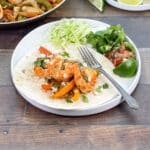
Shrimp Fajitas Recipe
- Prep Time: 10 minutes
- Cook Time: 15 minutes
- Total Time: 25 minutes
- Yield: 4 servings 1x
- Category: Entree
- Method: Saute
- Cuisine: Mexican
DESCRIPTION
To make the pan sizzle when you take it to the table, make sure it’s good and hot and then squeeze some lime juice over everything. To serve the fajitas, it’s great to have a selection of your favorite toppings. I like to have the following: Sour cream, pico de gallo, guacamole, shredded cheese, shredded lettuce, green onions.
Ingredients
- 1 lb. raw jumbo shrimp, peeled, deveined
- 1 and 1/4 tsp. salt, divided
- 3 Tbsp. olive oil, divided
- 3 bell peppers, sliced thinly
- 2 large onions, sliced thinly
- 2 Tbsp. Fajita Seasoning
- 8 small flour tortillas
- 3 Tbsp. vegetable broth or water
- 1/2 of a lime
Instructions
- Season shrimp with ¼ teaspoon of the salt.
- In a large skillet heat 1 tablespoon of the oil over medium-high heat until shimmering.
- Add shrimp. Cook for 2 minutes without moving them. Flip and cook the other side for 2 minutes. Remove shrimp from pan, set aside.
- Add remaining 2 tablespoons of oil to pan. Add peppers, onions, and remaining 1 teaspoon of salt. Toss to coat. Cook, undisturbed, 5 minutes or until vegetables are lightly charred on one side.
- Add fajita seasoning, toss to coat and redistribute vegetables. Cook, undisturbed, 3 minutes.
- Meanwhile, arrange tortillas on microwave-safe plate. Top with a damp paper towel and then with an inverted plate. Microwave 30 seconds at a time until heated through. Leave plate on top to keep tortillas warm until serving.
- To the vegetables, add the broth or water and stir. Add the shrimp to the pan, toss to coat them in the spices and then evenly distribute them. Cook another 2 to 3 minutes, or until shrimp are cooked through (they should be pink, opaque, and more curled than before).
- Remove pan from heat, squeeze lime over shrimp and vegetables. Serve immediately with warm tortillas.
Love this recipe? I’d appreciate it if you could scroll down and add a *5 star rating* to help others know they’ll love it as well!
This post originally appeared in May 2022 and was revised and republished in August 2023.


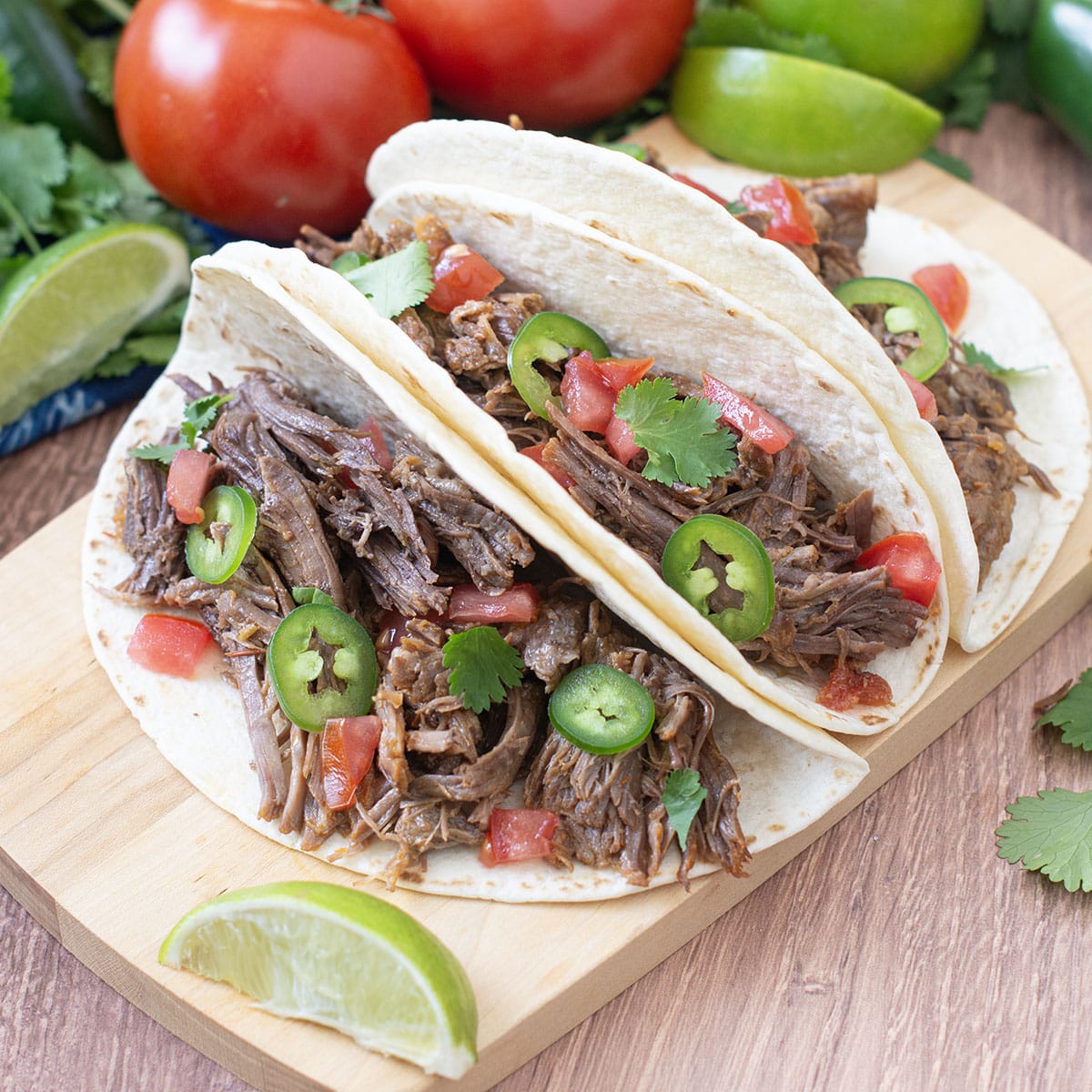
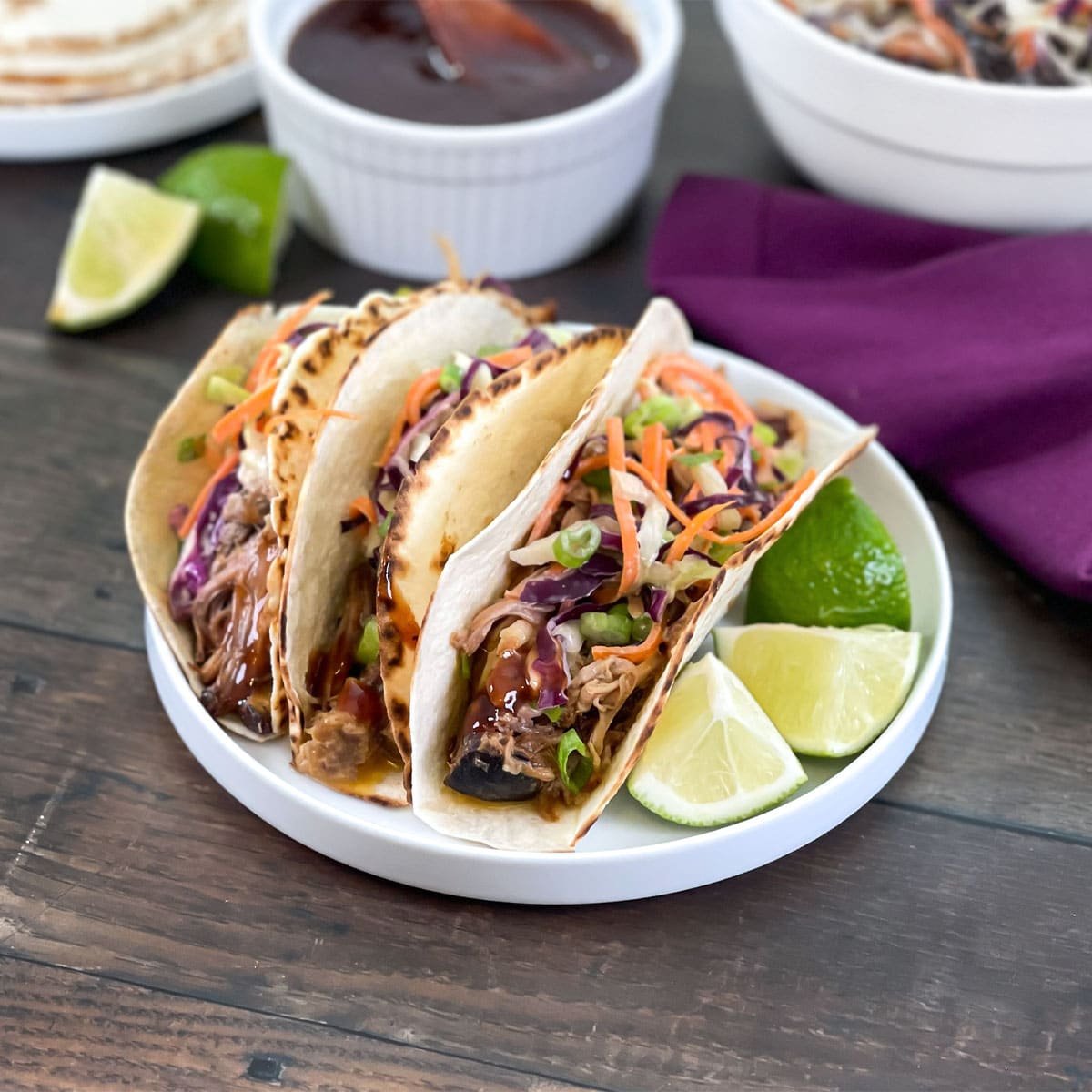
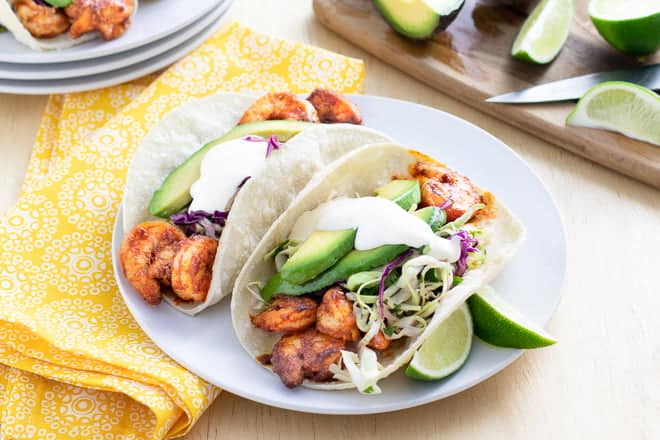
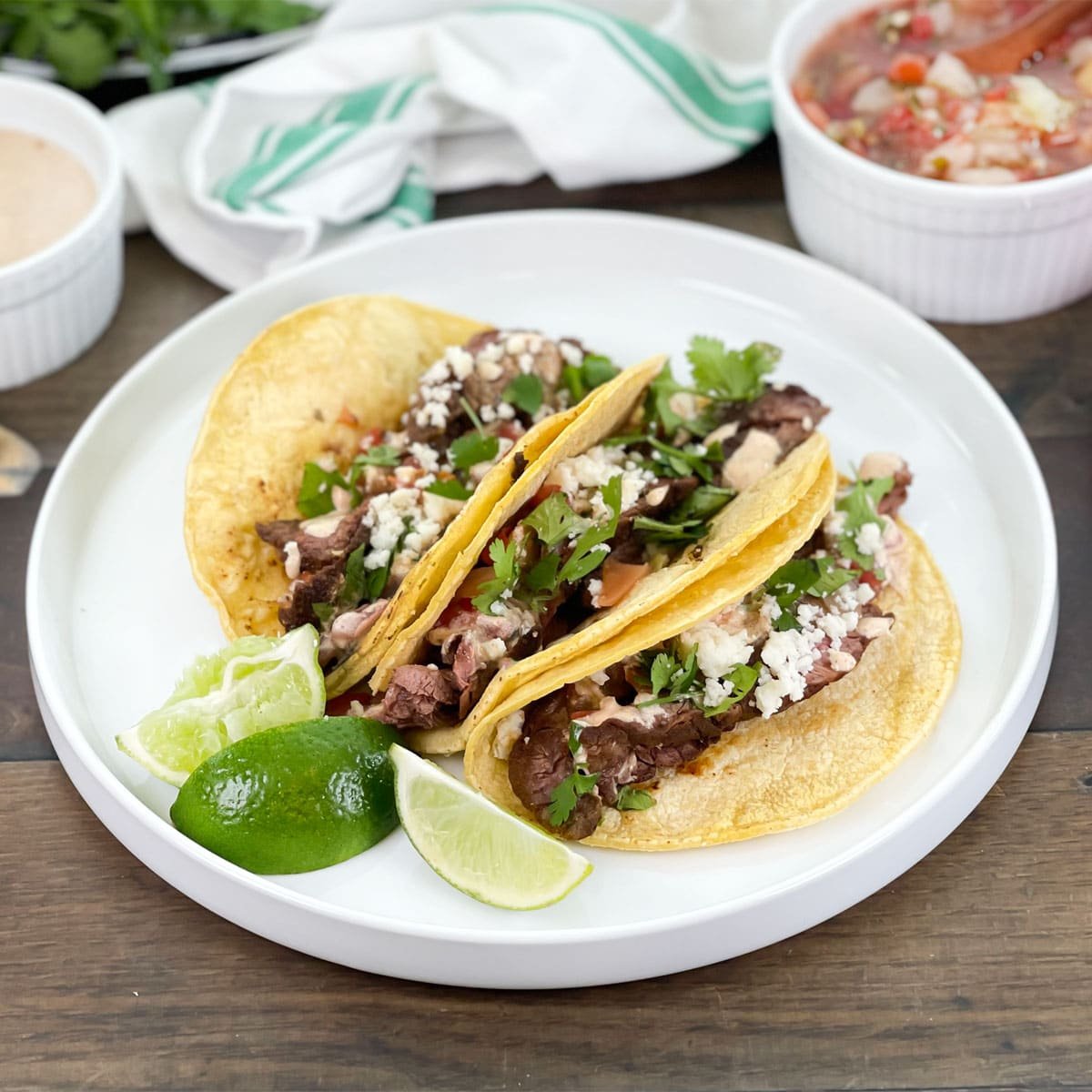



















I only have large shrimp. Would I still cook them 2 minutes per side? I can’t wait to try your recipe. It’s just what I was looking for.
Linda, yes, you should be fine with the initial 2 minutes per side for large shrimp. What you’re really trying to do at that step is to get a bit of a sear on them, not cook them through. So as soon as they have a touch of color, you can flip them.
Hi, I love the recipe I was smiling while I read it. Actually I do the same thing. Smiling because you confirmed that I was doing just fine. YAY! My question is how to fold the tortilla without making a mess of it. Help!
Yay, happy to confirm your method, Laura! I usually fold up the end and then fold over the sides to limit ingredients falling out. Of course, fillings ending up on your plate is just a good excuse to grab some tortilla chips to scoop them up.